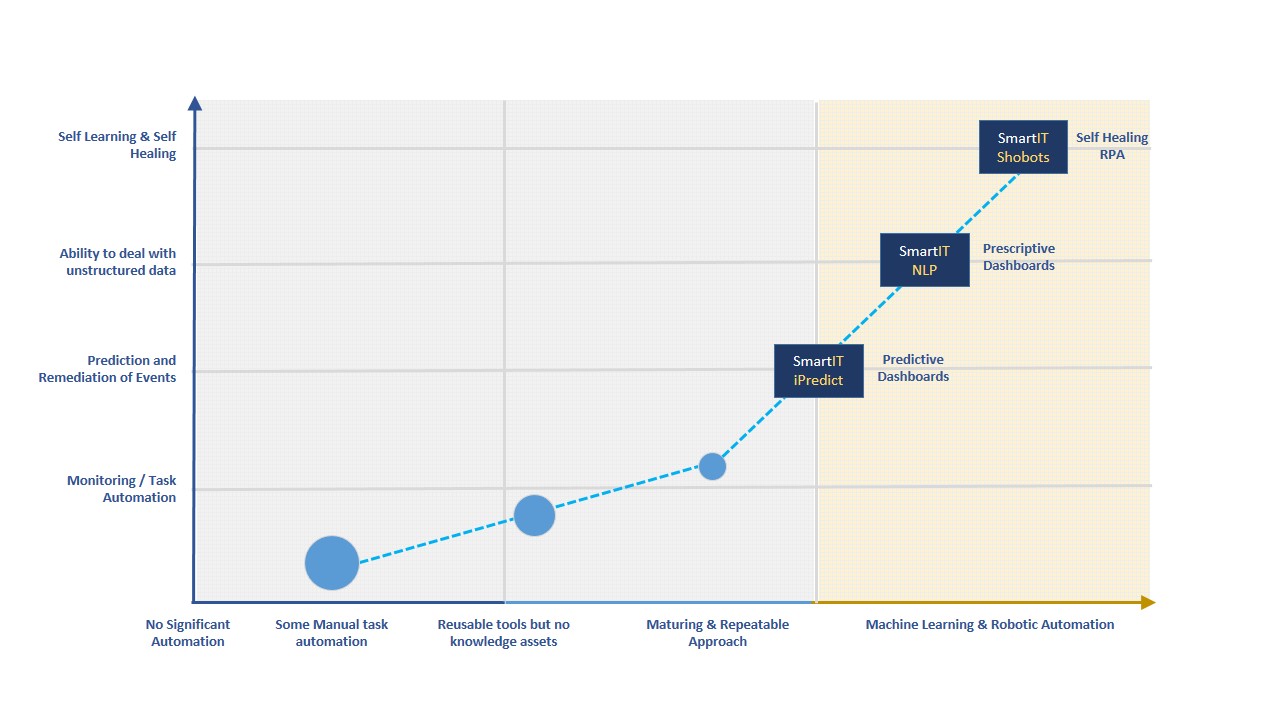Intelligent IT Automation – From Concept to Reality
Your road to leaner and digitized production support operations
Over the recent past, the financial services industry has seen a rapid acceleration in the adoption of digital technologies. It has embraced smarter, leaner operating models, especially within IT support functions. Apart from the ongoing digital revolution, this acceleration has also been triggered by the increasing need for companies to curtail costs. Digital disruption is the current ‘mantra’ for some of the world’s top banks and financial institutions, especially when it comes to technical support services.
But what are companies looking for in a next-generation IT support model? Key desired benefits are:
- Automation of a significant proportion of IT support processes
- Substantial reduction in TCO
- Reduced ticket volume
- Enhanced team productivity
- Decrease in SLA or governance reporting overheads
This may seem like a wish list. However, the above outcomes are vital if banks want to channel their ‘run the bank’ cost and effort to fuel ‘change the bank’ initiatives. In this blog, we will take a look at an effective way to realize these objectives.
Differentiated Model to Drive Digital Support Transformation
A next-generation support model should not only be stable, reliable, cost-effective, and scalable but should also use an integrated approach to truly realize the power of digitization. An ideal multi-level support model should integrate disparate applications, environments, infrastructure (software and hardware), and technology modules. It should cover a wide range of services, including monitoring, resolution, command center operations, release management, preventive maintenance, currency management, consolidation, and application maintenance.
The key challenge here is not limited to just identifying and deploying the right tools. Banks and FIs must also address the tremendous cultural shift involved in the transformation. It becomes tougher to address these challenges with increasing organizational size and complexity. Automation and state-of-the-art digital technologies alone will not help resolve these issues.
We think the following elements are critical in order to establish an integrated NextGen support model:
- A robust transformation framework to help shift support engagements to the desired end-state
- A high percentage of automated processes covering monitoring, health checks, resolution, releases, and governance reporting
- Cognitive automation
- Predictive analytics of events, root cause, and resolution
- Automatic interpretation of user inquiries and response formulation
- ‘Self-Healing’ to automate complex manual decision-making
- Coverage across support horizontals such as service desk, command center, and batch monitoring
Companies can achieve seamless automation by customizing commercially available tools and leveraging digital technologies and libraries. However, as process efficiency is an important lever in the overall digital journey, both automation and process efficiency levers should be combined to realize a powerful NextGen support model.
How Mature is Your Support Automation?
Before even transforming the support model, it is important for any bank to assess the automation maturity of their support services. The graph below demonstrates our automation maturity model based on 25 different factors:

Most banks and FIs fall somewhere in the middle of the curve in terms of maturity. The level of automation is generally high; however, with moderate business benefits. As you can see, NextGen Automation techniques (yellow shaded portion of the graph) seem to be the real tipping point. This is where banks and FIs need to focus.
What Efficiency can Levers be used?
The table below highlights the efficiency levers that can help achieve business benefits at multiple levels. The levels mentioned are based on our experience in applying these levers across a large number of support engagements:
| Lever | Benefits | Efficiency |
| Level 1 | ||
| Monitoring and alert automation |
| Upto 35% |
| Effective user training | ||
| Reduce email alerts | ||
| Self-service portal | ||
| Improve first closure rate | ||
| Command centre and service desk | ||
| Level 2 | ||
| Shift left and progressive horizontalization |
| Upto 25% |
| NLP driven User Request automation | ||
| End to End Automation | ||
| SWAT team driven resolution | ||
| Automated Incident management | ||
| Level 3 | ||
| Predictive Analytics driven problem management |
| Up to 15% |
| Effective and authoritative Change Management | ||
| Bots driven self-healing | ||
| Robotic automation of business processes | ||
Every bank or FI is structurally different and will encounter different challenges in implementing each lever. Hence, a staged approach, where each efficiency lever is implemented steadily from one level to another, is always the best course of action.
How can LTIMindtree help?
As our clients adapt to NextGEN AMS tools and processes, achieving the right balance between technology innovation and human skills is paramount to building a robust production support ecosystem.
Driving agility and client-centricity through teams on the ground have become important cornerstones of a successful operating model. The sensitive and serious nature of support operations requires a different mindset and rigorous training to efficiently perform the job. Along with technology, investing in the right people is equally important to build a sustainable execution model.
LTIMindtree has already delivered significant business benefits to clients on support engagements across the globe, using multiple efficiency levers and our MOSAIC Automation suite. The suite has components, such as SMART IT – a complete cognitive automation suite – and several full-suite automation tools and utilities. Our TEI and Horizontalization frameworks are robust blueprints for planning and executing complex support digital transformations and for commoditizing the support of horizontal services, respectively.
At LTIMindtree, we combine best-in-class analytics and automation expertise with our 20-plus years of experience managing extremely complex global operations to help our customers transcend the growing limitations of traditional, labor-intensive production support models.
We believe digitization is just a start and provides a strong foundation to continuously innovate and reap business benefits.
More from Vinod Nair
What is NexGen ADM? Does it mean development and maintenance using next-generation technologies…
Latest Blogs
The energy and anticipation were evident even before entering the arena, and attendees had…
A tectonic shift in wealth is underway, and agility is the key factor that will distinguish…
Educational institutions are at a crossroads where their future hinges on a single question:…
In times of market unpredictability, alternative investments offer a valuable advantage by…




